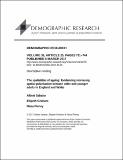Files in this item
The spatialities of ageing : evidencing increasing spatial polarisation between older and younger adults in England and Wales
Item metadata
| dc.contributor.author | Sabater, Albert | |
| dc.contributor.author | Graham, Elspeth | |
| dc.contributor.author | Finney, Nissa | |
| dc.date.accessioned | 2017-03-08T16:30:21Z | |
| dc.date.available | 2017-03-08T16:30:21Z | |
| dc.date.issued | 2017-03-08 | |
| dc.identifier | 249288607 | |
| dc.identifier | 67622a63-bdad-4bbd-9100-982624fdfe7b | |
| dc.identifier | 85014645301 | |
| dc.identifier | 000395658000001 | |
| dc.identifier.citation | Sabater , A , Graham , E & Finney , N 2017 , ' The spatialities of ageing : evidencing increasing spatial polarisation between older and younger adults in England and Wales ' , Demographic Research , vol. 36 , 25 , pp. 731-744 . https://doi.org/10.4054/DemRes.2017.36.25 | en |
| dc.identifier.issn | 1435-9871 | |
| dc.identifier.other | ORCID: /0000-0001-6602-9920/work/65014578 | |
| dc.identifier.uri | https://hdl.handle.net/10023/10426 | |
| dc.description.abstract | Background : With the proportion of older adults in Europe expected to grow significantly over the next few decades, a number of pertinent questions are raised about the socio-spatial processes that underlie residential age segregation, especially in circumstances where it may be increasing. Objective : We present evidence on whether, and to what degree, residential age segregation has changed across neighbourhoods in England and Wales since the 1990s. Methods : We examine the residential patterns of older adults (aged 65 and over) compared to those of younger adults (aged 25-40) for neighbourhoods across the country, for neighbourhoods within districts, and for neighbourhoods within districts classified by type. The analyses use harmonised population data for small areas (Output Areas) from the 1991, 2001, and 2011 Censuses of England and Wales. Results : The results reveal increasing segregation over time (1991-2011) between older and younger groups across neighbourhoods nationally. Although the index values of segregation tend to be higher in less urban areas, highlighting a strong age and life course dimension of the rural-urban divide, a rapid increase in age segregation is found in urban areas. Moreover, our findings suggest the existence of convergent clusters of increasing age segregation, particularly in urban settings (from small to large cities) and former industrial areas in the North of England, thus providing evidence suggesting a further dimension of the North-South divide. Conclusions : The findings demonstrate a growing age bifurcation over time and space, as both older and younger age groups are increasingly living apart. Although the drivers and consequences of these trends in residential age segregation remain unclear, the potential challenge to policies of social cohesion underlines the importance of further research. | |
| dc.format.extent | 14 | |
| dc.format.extent | 720254 | |
| dc.language.iso | eng | |
| dc.relation.ispartof | Demographic Research | en |
| dc.subject | Ageing | en |
| dc.subject | England | en |
| dc.subject | Neighbourhood | en |
| dc.subject | Residential segregation | en |
| dc.subject | Spatial analysis | en |
| dc.subject | Urban-rural composition | en |
| dc.subject | Wales | en |
| dc.subject | G Geography (General) | en |
| dc.subject | GF Human ecology. Anthropogeography | en |
| dc.subject | H Social Sciences | en |
| dc.subject | 3rd-DAS | en |
| dc.subject | BDC | en |
| dc.subject | R2C | en |
| dc.subject | SDG 10 - Reduced Inequalities | en |
| dc.subject.lcc | G1 | en |
| dc.subject.lcc | GF | en |
| dc.subject.lcc | H | en |
| dc.title | The spatialities of ageing : evidencing increasing spatial polarisation between older and younger adults in England and Wales | en |
| dc.type | Journal article | en |
| dc.contributor.institution | University of St Andrews. School of Geography & Sustainable Development | en |
| dc.contributor.institution | University of St Andrews. Geography & Sustainable Development | en |
| dc.contributor.institution | University of St Andrews. Centre for Population Change | en |
| dc.contributor.institution | University of St Andrews. Centre for Minorities Research (CMR) | en |
| dc.identifier.doi | https://doi.org/10.4054/DemRes.2017.36.25 | |
| dc.description.status | Peer reviewed | en |
This item appears in the following Collection(s)
Items in the St Andrews Research Repository are protected by copyright, with all rights reserved, unless otherwise indicated.

